The Consumer Price Index for February returned to Earth with a 0.1% monthly increase. January stayed unrevised at 0.6%. The monthly change was the smallest gain since July 2016. The main cause was gasoline, again, which dropped -3.0% for the month. Inflation with food and energy price changes removed increased 0.2%. From a year ago overall CPI has now risen 2.7%. Without energy and food considered, prices have increased 2.2% for the year. CPI measures inflation, or price increases.
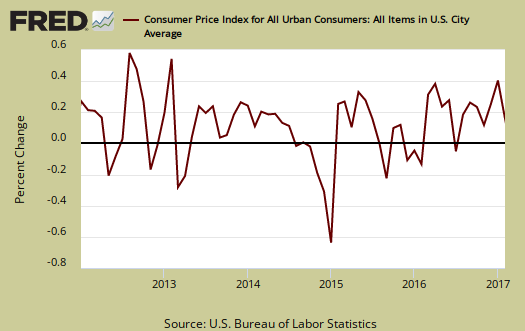
Yearly overall inflation is shown in the below graph and we can see the 2.7% increase is really a balloon in comparison to previous annual gains.
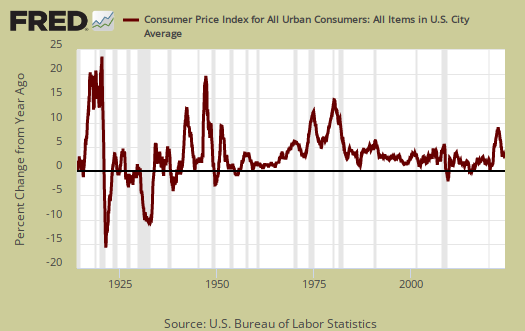
Core inflation, or CPI with all food and energy items removed from the index, has increased 2.2% for the last year. For the past decade the annualized inflation rate has been 1.9%. Core inflation is the figure the Federal Reserve considers for interest rate increase decisions and no surprise this is why they raised rates and probably will again based on these figures.

Core CPI's monthly 0.2% percentage change is graphed below. Within core inflation, shelter increased 0.3%, with monthly rental costs increasing 0.3% and home ownership equivalent rent increased 0.3%. Shelter overall is up 3.5% for the year with rent increasing 3.9% annually. Recreation soared up 0.6%, the largest increase since 2001. New cars decreased by -0.2% and used cars and trucks decreased by -0.6%. Education increased 0.3% for the month.

The energy index decreased -1.0% for the month and is now up 15.2% from a year ago. The BLS separates out all energy costs and puts them together into one index. For the year, gasoline has now increased 30.7%. Fuel oil is up 28% for the year, while dropped by -0.4% this month. Graphed below is the overall CPI energy index.

Graphed below is the CPI gasoline index annual percentage change and for the month gas dropped by -3.0%.

Graphed below is the rent price index which has been soaring for some time, now up 3.9% annually, and is shown in the below graph.
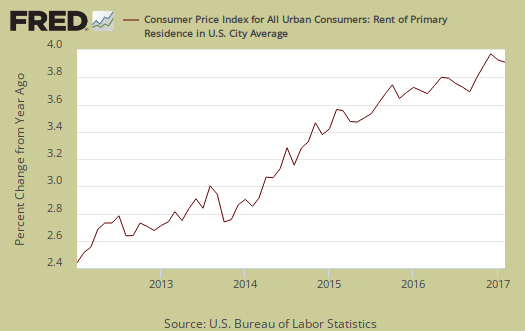
Food prices increased by 0.2% for the month. Food and beverages have now not changed from a year ago. Groceries, (called food at home by the BLS), increased 0.3% for the month, and are down -1.7% for the year. Nonalcoholic beveridges increased 1.5%, the largest jump since January 2011. Dairy and related products increased 0.8% for the month, the largest gain since May 2014 and the second month in a row for the same jump. Eating out, or food away from home increased 0.2% for the month and is up 2.4% for the year.
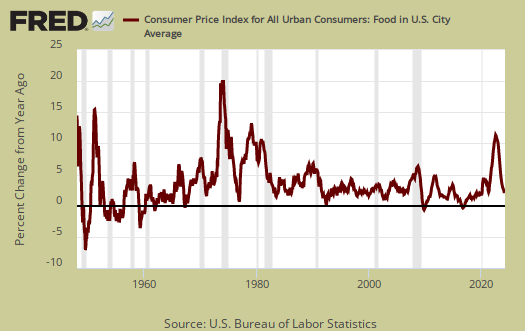
Graphed below are grocery prices, also referred to as the food at home index.
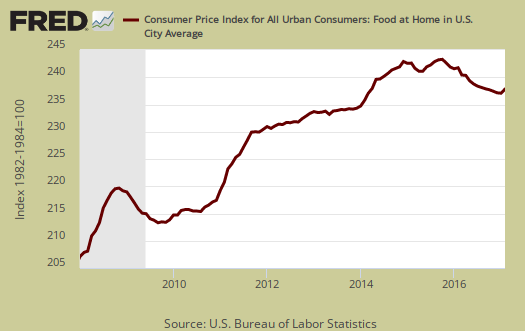
Medical costs are part of core inflation and are a never ending source of price increases. The Medical care index increased 0.1% for the month. Prescription drugs actually decreased by -0.2% as hospital services increased by 0.4%. Graphed below is the overall medical care index, which is up 3.5% from a year ago.

Below is a graph of the medical commodities index, which is mostly prescription drug prices and is down by -.2 % for the month, 4.1% for the year.
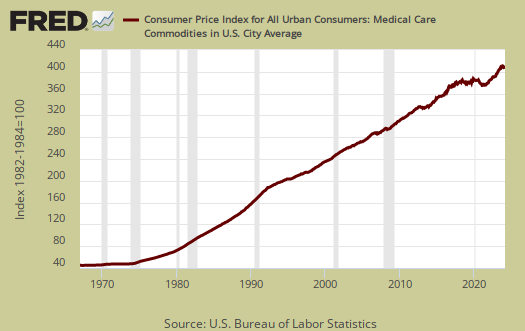
Real hourly earnings increased by 0.1% for all employees. Real means wages adjusted for inflation. CPI increased 0.1% while wages increased by 0.2%. For the year real hourly earnings have had no change. The average real hourly wage is now $10.67 and the average wage, not adjusted for inflation is $26.09. Weekly real earnings increased by 0.1% as hours worked did not change and weekly earnings increased by 0.2%. Real weekly earnings now stand at $367.14. The work week is 34.4 hours. There is a separate category for production and nonsupervisory employees and their real hourly earnings increased by 0.2% to $9.17 and their real weekly earnings increased 0.2% to $307.95. For the year production and nonsupervisory employees hourly and weekly earnings are down -0.3% and -0.4% respectively.
CPI details
The DOL/BLS does take yearly surveys on where the money goes in the monthly budget, but as one can see, food and energy are significant amounts of the monthly finances. Run away costs in these two areas can break the bank, so can food. Additionally CPI uses substitution, so if flour goes through the roof, somehow we're all just fine with oats and prices didn't really overall increase much. Here is the BLS CPI site, where one can find much more details, information on calculation methods and error margins.
Other CPI report overviews, unrevised, although most graphs are updated, are here. If you're wondering why the graphs display different figures from the text, the graphs calculate percentages from the index and do not round. The actual data from the BLS report does round to one decimal place. In other words, 0.05% is rounded to 0.1%.

Recent comments